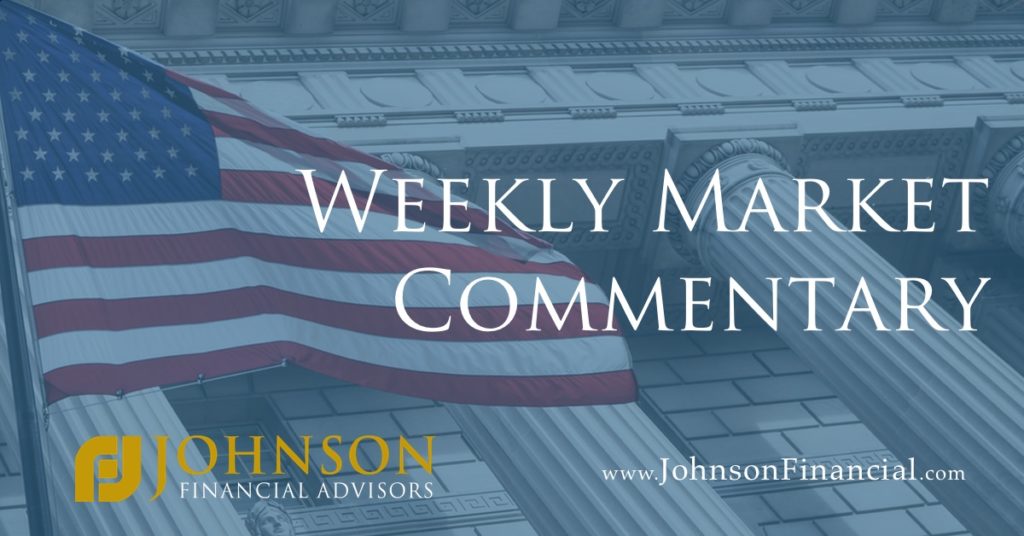
Weekly Market Commentary – 11/5/2018
For the Week of November 5, 2018
The Markets
Following three mid-week stock market rallies, stocks fell Friday. Trade concerns weighed on stocks after a White House official suggested no deal with China was at hand. On a positive note, the Labor Department’s October jobs report was well above expectations. For the week, the Dow gained 2.36 percent to close at 25,270.83. The S&P climbed 2.45 percent to finish at 2,723.06, and the NASDAQ rose 2.65 percent to end the week at 7,356.99.
| Returns Through 11/02/18 | 1 Week | YTD | 1 Year | 3 Year | 5 Year |
|---|---|---|---|---|---|
| Dow Jones Industrials (TR) | 2.36 | 4.05 | 9.89 | 15.12 | 12.80 |
| NASDAQ Composite (PR) | 2.65 | 6.57 | 9.56 | 12.79 | 13.41 |
| S&P 500 (TR) | 2.45 | 3.45 | 7.60 | 11.24 | 11.37 |
| Barclays US Agg Bond (TR) | -0.73 | -2.65 | -2.46 | 0.98 | 1.84 |
| MSCI EAFE (TR) | 3.36 | -8.17 | -6.26 | 4.20 | 2.49 |
Source: Morningstar.com. *Past performance is no guarantee of future results. Indexes are unmanaged and cannot be invested into directly. Three- and five-year returns are annualized. The Dow Jones Industrials, MSCI EAFE, Barclays US Agg Bond and S&P, excluding “1 Week” returns, are based on total return, which is a reflection of return to an investor by reinvesting dividends after the deduction of withholding tax. The NASDAQ is based on price return, which is the capital appreciation of the portfolio, excluding income generated by the assets in the portfolio in the form of interest and dividends. (TR) indicates total return. (PR) indicates price return. MSCI EAFE returns stated in U.S. dollars.
Half as Many — U.S. homebuilders started construction on 13.773 million single-family homes over the 10 years from 1998-2007, an average of 1.38 million per year. U.S. homebuilders started construction on 6.114 million single-family homes from 2008-2017, an average of 611,400 per year (source: Census Bureau, BTN Research).
Mom and Dad — The national median cost in 2017 for an assisted living facility (private one-bedroom accommodation) was $3,750 per month or $45,000 per year (source: Genworth, BTN Research).
Start Saving Now — A child born in 2018 who begins kindergarten in fall of 2023 would attend college between the years 2036 and 2040. If that child attended an average public in-state four-year college, and if the annual price increases for public colleges experienced over the last 30 years (5.4 percent per year) continue into the future, the aggregate four-year cost of the child’s college education (including tuition, fees, room and board) would be $237,262 or $59,315 per year (source: College Board).
WEEKLY FOCUS – The Challenge of Funding Long Term Care
Although nearly six in 10 Americans say saving for long term care (LTC) is a financial priority, three quarters of Americans have not planned for LTC needs.1 There are several possible explanations for this disconnect: costly premiums, steep premium hikes in the past, fewer providers, and insurers entering bankruptcy. Regardless of the challenges, it’s important to plan for potential long term care needs. Here is a broad survey of options to consider:
Self pay.This can come at a hefty price tag, but you don’t have to worry about premiums increasing, and you retain the funds if you don’t need them for LTC. Whether you’re using your 401(k), Roth IRA, annuities or savings, you need to understand the potential costs of home health care, assisted living and nursing homes.
Health savings accounts.Individuals who have an eligible high-deductible health insurance plan can make maximum contributions to an HSA (sometimes called a health IRA) and save them to fund long term care if they ever require it.
Traditional long term care insurance. Insurance companies are learning from past pricing mistakes, reducing the chances of future double-digit premium hikes. And with many policies, you can include an inflation rider to increase your daily benefit over time.
Short term care insurance. These plans are similar to long-term care insurance policies but cap benefits at one year. They’re less expensive overall and may be available to older seniors or those who aren’t otherwise eligible for long term coverage.
Combined life insurance with long term care benefits. Life insurance policies combined with long term care benefits have grown by 50 percent since 2012. Rates don’t typically go up sharply, but policies also don’t guarantee you’ll earn market rates. As an added benefit, your beneficiaries receive a tax-free death benefit if you don’t use the benefits.
Shared care insurance. A couple takes out identical LTC plans with an option that allows each spouse to have a rider on their spouse’s benefits. While the rider involves an added charge, the total is less than both spouses buying higher levels of protection.
Funding long term care can be complicated. Let us help you explore your options. Call our office today. 1
